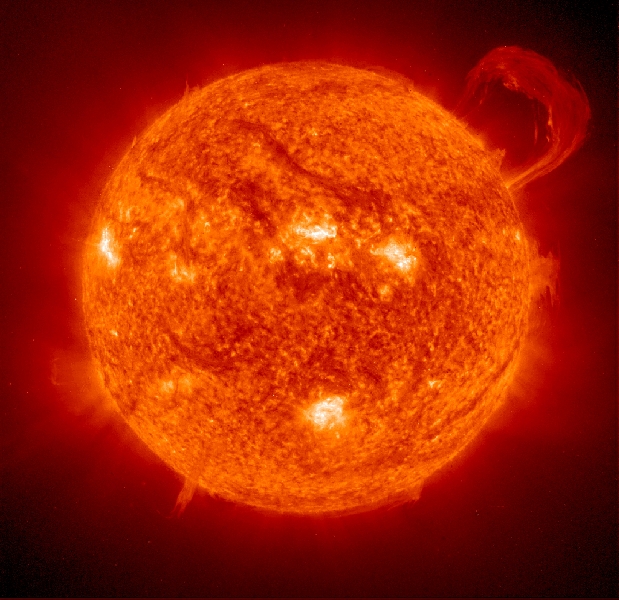







| BOOKS | F. A. Q. | ARTICLES | TALKS | ABOUT KEN | DONATE | BEYOND OUR KEN |
|---|
By Ken Croswell
January 19, 2006

The Sun: normal after all. Image by SOHO (ESA and NASA).
Sooner or later, the typical astronomy enthusiast learns a
shocking truth: most star systems are double or triple, with two or three stars orbiting one another. Thus, our single Sun is in the
minority. Now, however, an astronomer in Massachusetts says this "truth"
is false--because most star systems in the Galaxy are in fact single.
Certainly double and triple stars seem common. Sirius, the brightest star in the night, is double, and Alpha Centauri, the nearest star system to the Sun, is triple. Furthermore, most yellow G-type stars like the Sun have stellar companions.
 But Charles Lada of the Harvard-Smithsonian Center for
Astrophysics says what really counts are red dwarfs--stars much
fainter and cooler than the Sun--because they make up the vast
majority of stars. In recent years, red dwarf surveys have found
that most of these dim stars are single.
But Charles Lada of the Harvard-Smithsonian Center for
Astrophysics says what really counts are red dwarfs--stars much
fainter and cooler than the Sun--because they make up the vast
majority of stars. In recent years, red dwarf surveys have found
that most of these dim stars are single.
This trend shows up even among the Sun's nearest neighbors (see table below). The closest red dwarf, Proxima Centauri, is part of a triple star, but the next nearest red dwarfs--Barnard's Star, Wolf 359, and Lalande 21185--are all single.
When Lada works out the numbers, he reaches a conclusion you won't find in any astronomy textbook: two thirds of all star systems in the Milky Way are single. Moreover, that fraction would be still higher had he included brown dwarfs. Born with even less mass than red dwarfs, brown dwarfs can't sustain hydrogen fusion, and they are even likelier than red dwarfs to be loners.
"In general, I agree with what Charles did," says Helmut Abt, an astronomer at Kitt Peak National Observatory in Tucson, Arizona, who began studying the frequency of binaries three decades ago. Abt says a key issue is what these results imply about how binaries form, and he notes that Lada's results agree with computer simulations that model the motions of young stars in dense star clusters. In these simulations, massive stars tend to acquire massive companions and eject low-mass stars, such as red dwarfs. Says Abt, "It seems to provide a very clear, simple explanation for why you have a high binary frequency for massive stars, like B stars; a moderate one for G stars; and a very low binary frequency for M dwarfs."
Lada says the high single-star fraction of red dwarfs is good news for planet hunters, because planets may form most easily around single stars. In contrast, if a star system is multiple, one star's gravity may perturb the disk of gas and dust that's trying to give birth to planets around another star, preventing planets from developing. Thus, says Lada, red dwarfs may have solar systems with the same architecture and stability as our own. This, of course, raises the chance that red dwarfs could support life-bearing worlds.
Lada has submitted his work to Astrophysical Journal Letters.
Ken Croswell is an astronomer and the author of Magnificent Universe and See the Stars: Your First Guide to the Night Sky.
"Magnificent Universe by Ken Croswell is elegant and eloquent."--Washington Post. See all reviews of Magnificent Universe here.
"Finally! An astronomy guide that the reader can actually follow without being a rocket scientist!" See all reviews of See the Stars here.
| Star | Single?
|
| Proxima Centauri | NO
| Barnard's Star | YES
| Wolf 359 | YES
| Lalande 21185 | YES
| Luyten 726-8 | NO
| Ross 154 | YES
| Ross 248 | YES
| Lacaille 9352 | YES
| Ross 128 | YES
| Luyten 789-6 | NO
| Struve 2398 | NO
| Groombridge 34 | NO
| Giclas 51-15 | YES
| |
Adapted from page 189 of Magnificent Universe. All these stars are less than 12 light-years from the Sun.
| BOOKS | F. A. Q. | ARTICLES | TALKS | ABOUT KEN | DONATE | BEYOND OUR KEN |
|---|